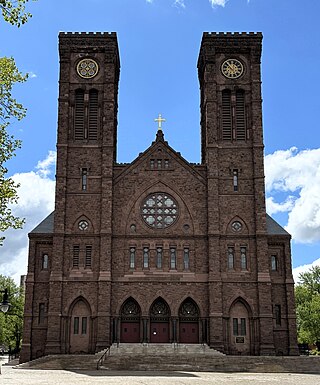
The Diocese of Providence is a Latin Church diocese of the Catholic Church in Rhode Island in the United States. The diocese was erected by Pope Pius IX on February 17, 1872.

The Cathedral of St. Joseph in Hartford, Connecticut, United States, is the mother church and seat of the Archdiocese of Hartford. Dedicated on May 15, 1962, it stands on the site of the old cathedral which had been destroyed in a fire. It is located on Farmington Avenue just outside downtown Hartford.

Heins & LaFarge was a New York City–based architectural firm founded by Philadelphia-born architect George Lewis Heins (1860–1907) and Christopher Grant LaFarge (1862–1938), the eldest son of the artist John La Farge. They were the architects for the original Romanesque-Byzantine east end and crossing of the Cathedral of St. John the Divine in Manhattan, and for the original Astor Court buildings of the Bronx Zoo, which formed a complete ensemble reflecting the aesthetic of the City Beautiful movement. Heins & LaFarge provided the architecture and details for the Interborough Rapid Transit Company, the first precursor to the New York City Subway.

Thomas Francis Hendricken was an Irish-born American prelate of the Roman Catholic Church. He served as the first bishop of the Diocese of Providence in Rhode Island from 1872 until his death in 1886.

The Episcopal Diocese of Rhode Island is a diocese of the Episcopal Church in the United States of America, encompassing the state of Rhode Island. It is one of seven New England dioceses that make up Province 1.
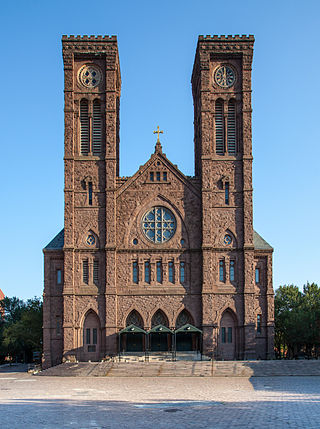
The Cathedral of Saints Peter and Paul is a Roman Catholic cathedral in the Cathedral Square neighborhood of Providence, Rhode Island, United States. It is the mother church of the Diocese of Providence. The Neo-Romanesque church was designed in 1873 by Patrick Keely and added to the National Register of Historic Places in 1975.
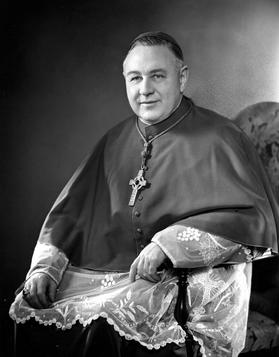
Francis Patrick Keough was an American prelate of the Roman Catholic Church. He served as bishop of the Diocese of Providence in Rhode Island from 1934 to 1947 and as archbishop of the Archdiocese of Baltimore in Maryland from 1947 until his death.

Russell Warren (1783–1860) was an American architect, best known for his work in the Greek Revival style. He practiced in Bristol and Providence.
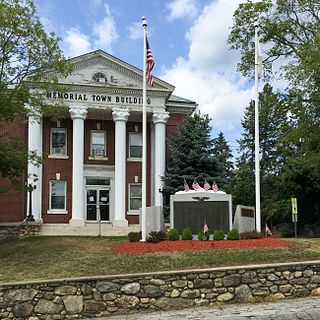
Slatersville is a village on the Branch River in the town of North Smithfield, Rhode Island, United States. It includes the Slatersville Historic District, a historic district listed on the National Register of Historic Places. The historic district has been included as part of the Blackstone River Valley National Historical Park. The North Smithfield Public Library is located in Slatersville.

University Hall is the first and oldest building on the campus of Brown University in Providence, Rhode Island. Built in 1770, the building is one of only seven extant college buildings built prior to the American Revolution. According to architectural historian Bryant F. Tolles Jr., the structure is "one of the genuine icons of early American collegiate architecture."
Edward Tuckerman Potter was an American architect best known for designing the 1871 Mark Twain House in Hartford, Connecticut. With his half-brother William Appleton Potter, he also designed Nott Memorial Hall (1858–79) at his alma mater, Union College, Schenectady, New York. Both the Mark Twain House and Nott Memorial Hall are National Historic Landmarks.

S. Stephen's Church is an historic Episcopal church located at 114 George Street in the College Hill neighborhood of Providence, Rhode Island. It is in the Brown University campus and is an active parish in the Episcopal Diocese of Rhode Island.

Grace Church is an historic Episcopal church at 300 Westminster Street at Mathewson Street in downtown Providence, Rhode Island. It was built in 1845–1846 and was designed by Richard Upjohn in the Gothic Revival style.
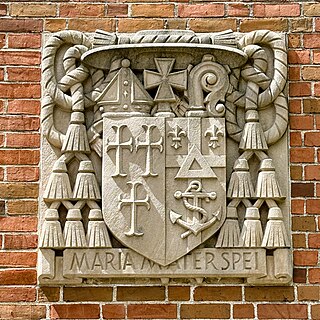
Russell Joseph McVinney was an American prelate of the Roman Catholic Church. He served as bishop of the Diocese of Providence in Rhode Island from 1948 until his death in 1971.
William Augustine Hickey was an American prelate of the Roman Catholic Church. He served as bishop of the Diocese of Providence in Rhode Island from 1921 until his death in 1933.

Clifton A. Hall (1826-1913) was an American architect from Providence, Rhode Island.
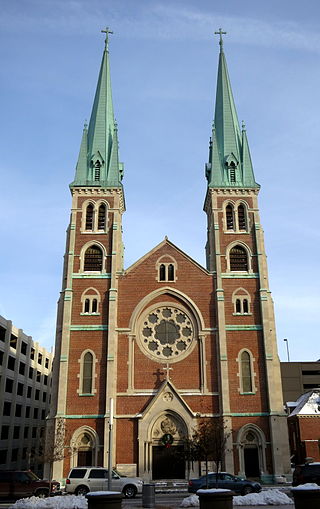
Saint John the Evangelist Catholic Church is a Catholic parish of the Archdiocese of Indianapolis in Indianapolis, Indiana, United States. The parish's origins date to 1837, when it was first named Holy Cross parish. In 1850 it was renamed Saint John the Evangelist parish, and is the oldest Catholic parish in the city and in Marion County, Indiana. Considered the mother of the Catholic parishes in Indianapolis, it played an important role in development of the Catholic Church in the city. Saint John's Church served as the pro-cathedral of the diocese from 1878 until 1906; its rectory served as the bishop's residence and chancery from 1878 until 1892. In 1900 the church served as the site of first episcopal consecration held in Indianapolis.

John Holden Greene (1777-1850) was a noted early nineteenth century architect practicing in Providence, Rhode Island. The bulk of his work dates to the late Federal period, and is mostly in the architectural style of the same name. Greene is responsible for the design of over fifty buildings built in the city between 1806 and 1830, almost half of which are still standing.
Frederick Barton Wolf was bishop of the Episcopal Diocese of Maine from 1968 to 1986.
John Seville Higgins was bishop of the Episcopal Diocese of Rhode Island, serving from 1953 to 1954 as coadjutor and from 1955 to 1972 as diocesan.





















